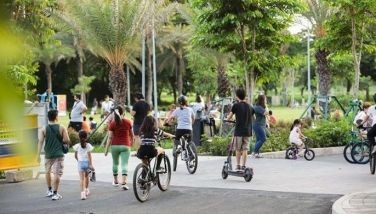Visiting Paete during Holy Week; Balangay spirit

I avoid going to Paete, my hometown, during Holy Week. In one visit in the past, the heat was suffocating and pressing crowds in little streets just too much to bear. But then I had no compelling reason to go there. This time I had. I wanted to find out more about the house that Felipe Roxas painted in 1880 “House by a Bridge†in Paete. It was a post in FB by Imelda Cajipe Endaya whose family also comes from the town. Could the original identity of the house still be known?
The painting did not look anything like the house that stands there now, but my sister said she remembers it not because of the house but because of the concrete bridge. There is only one concrete bridge and she remembers it was not far from the market.
The Roxas painting was a bigger house in the Spanish mold of the mid to late 19th century. But the Japanese burned down the whole town including the Spanish house by a bridge. There are not many houses of that kind anymore but it does hint at a story. It turns out that the present occupant/owners (?) are distant relatives but there was only an old woman seated on a bench and she was too old and tired to answer any questions. So the quest continues.
* * *
The house by the bridge was not the only thing that changed in Paete. I used to spend my school holidays and stayed with a grandmother. Our hosts Nilo and Mac Valdecantos have a thriving business with a café and gallery, a fitness center and a dental clinic. Their house has a big garden and serves as a hotel cum bed and breakfast. So all in all, the town may not be prosperous but it is pulling through with almost every family with a member working abroad.
We could only have enough time to do a quick round of the town and watch a procession they call poon-poonan, miniatures of the life size figures for the real procession. Nilo rhapsodized about the poon-poonan procession because of its humble origins. It used to be child’s play when young Paetenos would use mud, make their own santos and decorate these with flowers and have their own procession. The child’s play evolved and he said it gives him the shivers to think that their child’s play has come this far. We would not really miss the procession of the big santos because the small ones, the poon-poonan were good miniatures and it passed right in front of the hotel. The Adea family to which I belong takes care of the statue of St. John the Baptist which means we house it and dress it appropriately for the yearly ritual.
Sonia Adea-Paelmo and her husband Phil took care of our meals. Paete cuisine is special and has to be ordered days ahead. My favorites are sinigang na karpa (carp getting rarer to catch), hipon sa gata (small shrimps that are crisped and cooked until dry in coconut milk and their version of bibingka which is infused with kamoteng kahoy (cassava). There were many more dishes that they prepare in their own way and these have been passed on through generations.
* * *
Although Paete is a fourth class municipality, it has a rich history surpassing other towns in the Philippines. It was founded in 1580 by Spanish friars Juan de Plasencia and Diego de Oropesa of the Franciscan Order. The best example of its medieval history is the church, one of the oldest. Its exterior is made of bricks fashioned after the original but more thought should have been given to modern additions of concrete buildings adjacent to it.
I was equally saddened that to date nothing has been done about the floor to ceiling oil paintings of San Cristobal, the mythical hero who carried the Child Jesus across the sea. One was a Spanish and the other a native version. It is the Spanish version that had been destroyed, perhaps beyond repair if nothing is done soon. We had tried to work something out last year with the National Historical Commission but nothing came of it. I hope that the quarreling factions will find a way to agree on its restoration. I think the best umpire to save the unique and valuable paintings is newly elected Mayor Bagabaldo.
* * *
I once attended a spring festival organized by the Chinese embassy at the Rizal Park. There were several booths with particular towns showing its tradition of handicraft. There were embroidered silk shawls, kites and woodcraft. Each town had a history of its handicraft and how they preserved the tradition. Rizal Park may be a central venue but the message was lost on the Sunday strollers.
I thought a better idea would have been to make a joint festival of arts and crafts with towns like Paete. As the woodcarving capital of the Philippines and a still surviving paper mache crafts, contact with their Chinese counterparts should be good both for friendship and exposure. This is a better way to cement friendships between peoples. Paete had hosted a visit of the Spanish ambassador and the rest of the embassy and told me they could do the same with other countries with common interests. The historical connections with Mexico, Cuba, the US, China, even Japan may be a good starting point for such festivals of friendship.
It is said that the earliest inhabitants of Paete were Malays who came riding in their own version of the balangay and ultimately settled there.
* * *
So include Malaysia in the list. Indeed, better still if it could be inspired by the blogsite www.balikBalangay that has been promoting a return to those days. With the history of the balangay in mind all countries around the disputed South China Sea can work together to preserve, manage and develop the sea that can benefit all with its rich resources.
It may be time to resurrect Art Valdes’s The Balangay: Maritime Connectivity and Migration.
“The inspiration for this project comes from the maritime achievements of our ancestors. Sailing along the South China Sea, the Gulf of Thailand and the Java Sea despite the presence of obstacles and dangers, our people considered the seas to be unifying rather than divisive. It is a means of transport and communication. In fact, nearby countries have their own version of the balangay. There is the tatara for Taiwan, the lepa for Malaysia and perahu for Indonesia.â€
- Latest
- Trending






















